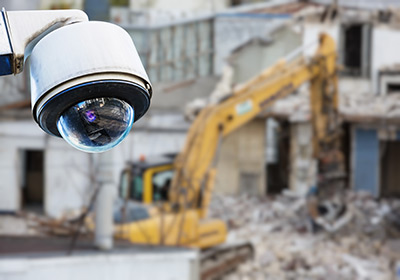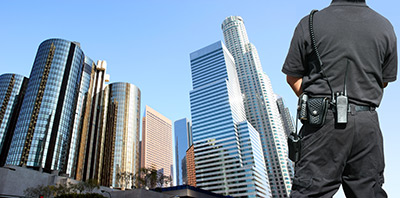
Night vision for outdoor cameras Infrared (thermal imaging) 24/7 active monitoring Communication/escalation protocols Will they perform a consultation and site review prior to dispatching a technician for installation? Will they review project schematics and provide a detailed description of camera locations and coverage radius? How will cameras operate if power is lost, or vandalism occurs?

If you’re going to use off-hours security, consider using off-duty policemen and positioning check points (QR or bar codes) such that the security guard can scan throughout the job site, ensuring routine rounds are being made. Involve neighbors in watching the job site. Post signs notifying the public that video surveillance is in effect on the premises. Although plywood/privacy screening may be used for downtown sites, it is wise to include periodic sections of chain link to
allow a view of the project from the street by passing traffic and patrols. Whenever possible, use a “just in time” approach for high valued items. Use high security locks with hardened or multi-strand cable to secure equipment and storage containers with equipment.
Addressing Project Site Security With Active Monitoring Systems
January 22, 2019
Seven significant construction project fires caused over $100 million in damage in 2018. Since 2009, there have been over 45 major fires at multifamily housing construction projects nationwide1. All of this has resulted in an increase in builder’s risk rates, primarily for frame construction. Some insurers have gone so far as to decline writing any frame construction habitational projects, or leave the builder’s risk market all together.
Buildings under construction have a greater potential for significant property damage from fire than occupied buildings. This is due to unprotected structural components, floors, and wall openings; combustible building materials and construction debris; temporary heating equipment; and “hot work” processes. In addition, fire suppression systems are often not in place or operational until a later stage in construction, increasing the likelihood that a fire spreads before manual firefighting can take place.
Traditional Site Security
The escalating demands for in-city living has resulted in an increased number of projects in densely populated areas, especially in cities with high job growth. Common challenges on these project sites include theft, vandalism, and liability from site accidents. Most builder’s risk quotations/policies will require that the project site be fully fenced and well-lit at a minimum.
Nevertheless, a project site should also have sturdy perimeter fencing with a limited number of access points. Site lighting should remain on after construction hours and through the night, as allowable by local ordinances, or at a minimum be motion activated with primary lighting focused along the perimeter of the job site. Any additional lighting should be located near the materials and equipment storage areas.
…[M]any insurers are now beginning to require security cameras as part of site security requirements.
Construction sites face steep losses when expensive equipment, tools, supplies, and materials are stolen, damaged, or vandalized. In addition to the financial impact from theft or damage, a project can also experience significant delays that can have an even greater financial impact than the theft or damage.
Traditional site security and insurance requirements for projects have included fencing, lighting, and security guards. However, depending on the size of a project site, the effectiveness of guards can be somewhat limited. As such, many insurers are now beginning to require security cameras as part of site security requirements. Further, with the developments in technology and the increasing number of service providers, security cameras can be less expensive than traditional static guards or mobile patrols, in some cases up to 30 percent more cost effective. In some instances, insurers will accept monitored security cameras in lieu of afterhours guards.
Depending on the duration and site size of a project, the infrastructure and investment in security systems may need to be scaled as the project proceeds. Often additional cameras are necessary due to the site perimeter becoming obscured as vertical construction advances. Most site security systems are designed to be completely standalone and can operate without the need for hard lined power or fixed line communication, meaning they don’t hinder the onsite electrical work or require additional power that won’t be part of the final project.
What are the basic benefits of a monitored camera system for developers and general contractors?
- Peace of mind as the site is being monitored during off-hours, including weekends and holidays.
- Proactive identification of suspicious activity and prevention of live crimes in progress.
- Recording and storage of site activities 24×7, creating an archive that can be used to access and research incidents that may have occurred onsite.
- Remote access to the cameras, enhancing project management and daily oversight of progress.
In addition to potentially preventing intrusion and providing response if an intrusion occurs, active monitoring can help combat other common problems onsite. For example, cameras can be placed in areas of vulnerability, with operators trained to look for smoke or flames as a primary focus. Notifying local fire departments of fire risk in real time can quickly resolve an incident that otherwise may have resulted in a total loss. Most thermal imaging cameras that are currently deployed to sites can be used to detect heat in certain situations, potentially preventing millions in damages. Additional value is derived when site monitoring is utilized for operational improvements, such as monitoring of doors left ajar, lights remaining on, equipment plugged in after hours, and more.

Designing Active Site Monitoring System
Video surveillance can be a valuable addition to any construction site. However, there are many important factors to consider first in order to create the right system for your needs:
- What is your most significant security threat?
- Have you experienced theft problems in the past? If so, what kinds and where?
- What kind of security do you currently have in place?
- Do you feel that your surroundings contribute to your overall security? Projects in existing residential areas may experience fewer problems than those in industrial areas or residential areas under construction.
There are several items and questions you should review with your potential site security vendor to ensure they are included in your system before deployment:
- Wireless or hardwired equipment?
- Internet Protocol (IP) cameras/netcams as opposed to closed circuit television cameras Offers ability to check images through any secure Internet connection
Regardless of the system’s final design or your vendor selection, a robust site security system should always include the following:
- Automated real time alert notification, with the ability to check images through any secure Internet connection
- Audible alarm – remote controlled, or motion or audio activated
- Night vision/infrared cameras for outdoor placement
- Motion activated cameras
- Two way audio with talk down capability (i.e. ability for security operator to communicate with detected perpetrator)
- Wireless equipment
- Video database
- Digital and satellite transmission enabled for use in remote locations

In addition to monitored security cameras, some companies offer motion detection as well as perimeter protection through invisible fences with silent alarms. These systems allow the monitor to contact civil authorities while watching the intrusion in real time, leading to apprehension of an intruder as opposed to an audible alarm or talk down system, which may scare an intruder off rather than allow for apprehension.
There are other steps that can be taken to tighten site security, outside of setting up an active monitoring system.
- Contact law enforcement and provide them with the details of your project, work schedules, and expected completion of the project.
- Contact information of key personnel should be exchanged.
Finally, there is no “silver bullet;” a combination of security strategies will be your best defense. Call an experienced risk manager or
insurance broker to learn more about these system requirements and design
options. If you are a victim of a site intrusion, notify law enforcement and take immediate corrective action to prevent reoccurrence.
Resources and References
- https://www.sfchronicle.com/business/article/Oakland-isn-t-alone-Costs-spike-nationwide-13342236.php
The views and opinions expressed within are those of the author(s) and do not necessarily reflect the official policy or position of Parker, Smith & Feek. While every effort has been taken in compiling this information to ensure that its contents are totally accurate, neither the publisher nor the author can accept liability for any inaccuracies or changed circumstances of any information herein or for the consequences of any reliance placed upon it.


